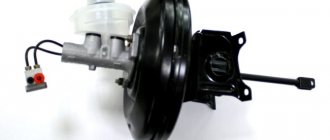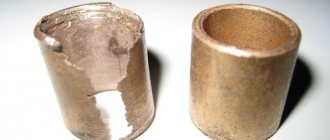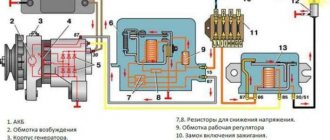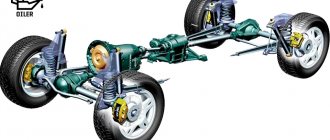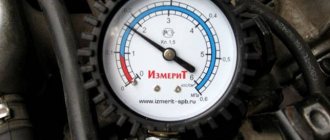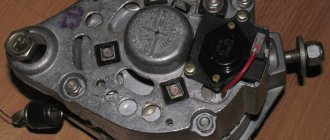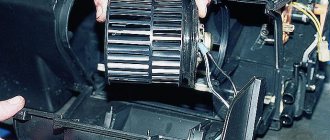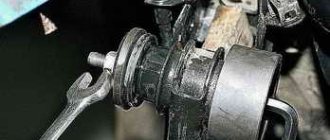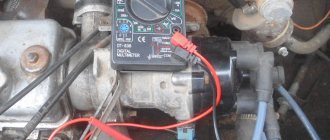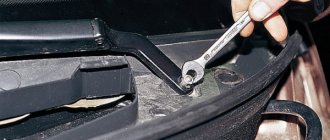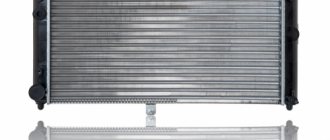On VAZ-2110 equipped with engines with an injection power system, the crankshaft speed of the power plant at idle is maintained by the XX (IAC) regulator.
The task of this element is to stabilize and maintain crankshaft speed at a given level under different conditions - abruptly releasing the gas pedal, creating a significant load on the on-board network (when the heater, headlights, etc. are turned on). A malfunction of the VAZ-2110 idle speed control does not affect the performance of the engine, but the lack of idle speed causes a number of inconveniences when operating the car.
Diagnostics and replacement of rcx and dpdz
I hope the information from this post will be useful and will be useful to someone! Good luck on the roads and a full tank!
The “symptoms” of a faulty throttle position sensor include the following:
1. Increased idle speed. 2. The engine stalls in neutral gear. 3. Idle speed floats. 4. Jerks during acceleration. 5. Deterioration in dynamics. 6. In some cases, the Check Engine light may come on.
Diagnosis of the throttle position sensor is carried out as follows:
1. Turn on the ignition, then check the voltage between the slider contact and the minus with a voltmeter. The voltmeter should show no more than 0.7 V. 2. Next, turn the plastic sector, thereby fully opening the damper, then measure the voltage again. The device should show at least 4 V. 3. Now turn off the ignition completely and pull out the connector. Check the resistance between the slider contact and any terminal. 4. Slowly, turning the sector, monitor the voltmeter readings. Make sure that the needle moves smoothly and slowly; if you notice jumps, the throttle position sensor is faulty and must be replaced.
Replacing the throttle position sensor:
1. Disconnect the wire from the “–” terminal of the battery. 2. Disconnect the block with wires from the throttle position sensor by pressing the plastic latch. 3. Unscrew the two mounting screws and remove the throttle position sensor from the throttle pipe. 4. Install the new sensor in the reverse order, but do not forget about the foam ring. The throttle position sensor does not require any adjustment, since the controller perceives idle speed (i.e. the throttle valve is completely closed) as the zero mark.
The “symptoms” of a faulty idle speed sensor include the following:
1. Spontaneous unregulated change in engine speed (sudden decrease or increase). 2. When turning on a “cold” engine, there is no increase in speed. 3. When using additional vehicle devices (heater, headlights), the idle speed is simultaneously reduced. 4. The engine stalls at idle and when shifting gears. It is necessary to remember that the readings of the VAZ 2110 injector idle speed sensor are not “readable” by the automatic on-board power system, and it is not integrated into the “Check Engine” alarm system.
Diagnostics of the idle speed controller is carried out as follows:
There are several ways to analyze the idle speed sensor, but the main ones - the simplest and most effective - are the methods described below:
First way:
1. First you need to “get” to the device, disconnect it from the connecting block of wires 2. Using the most common voltmeter, check for the presence of voltage - the “minus” goes to the engine, and the “plus” to the terminals of the same block of wires A and D. 3. Turns on ignition, and the received data is analyzed - the voltage should be within twelve volts, if less, then most likely there are problems with the battery charge; if there is no voltage, then you will have to check both the electronic control unit and the entire circuit. 4. Then we continue the inspection with the ignition on, and analyze terminals A:B, C:D one by one - the optimal resistance will be about fifty-three ohms; During normal operation of the IAC, the resistance will be infinitely high.
Second way:
Also, with the sensor removed and the ignition on, if you connect a power supply to it, the conical needle of the sensor should move out; if this does not happen, it means it is faulty.
Third way:
1. Remove the negative terminal of the battery. 2. Disconnect the IAC from the block harness. 3. Using a multimeter, we measure the resistance of the external and internal windings of the IAC, while the resistance parameters of contacts A and B, and C and D should be 40-80 Ohms. 4. If the instrument scale is zero, it is necessary to replace the IAC with a serviceable one, and if the required parameters are obtained, we check the resistance values in pairs B and C, A and D. 5. The instrument must detect an “open circuit.” 6. With such indicators, the IAC is in good working order, and if they are absent, the regulator must be replaced.
If the problem lies precisely in the operation of the regulator, then you should not rush and immediately go to a car service center, since you can clean the idle speed sensor yourself, as well as replace it.
Cleaning and replacing the idle air control.
The first thing you need to do is purchase a carburetor cleaner, and then get down to business: 1. The wire block is disconnected from the sensor. 2. Afterwards, both of its fastenings are unscrewed, and the sensor is removed. 3. If necessary, the IAC is completely cleaned of possible debris and contaminants on the cone needle and spring. 4. Also, do not forget to clean the mounting hole on the throttle assembly, where the conical needle of the sensor enters. 5. After cleaning, install everything in its original location.
If nothing has changed in the operation of the car - the same problems and inconveniences are present - then the regulator should be replaced.
It is worth noting that when purchasing you need to pay attention to the end mark 04. Sensors are produced with mark 01 02 03 04, so look at the mark of the old sensor and purchase the same one. If you put, for example, a sensor labeled 04 instead of 01, the sensor will not work. The following replacement is allowed: 01 to 03, 02 to 04 and vice versa.
Replacing the idle speed sensor can also be done without any problems:
1. The on-board system of the car is de-energized. 2. The block with wires is disconnected from the XX regulator. 3. The screws are unscrewed and finally the sensor is removed. 4. Attach the new device in the reverse order.
VAZ 2110 1.5 8kl for January 5.1.1. No control pxx.
Welcome to ChipTuner Forum.
Theme Options
Guys, I need some advice. I have a VAZ 2110, there are problems with starting the engine, intermittent 50/50. For cold and hot.
If the launch is successful: When the ignition is turned on, the pxx moves to the 120-step position, and at the moment of startup, after a second it begins to adjust the speed and the steps change 45-75 depending on the sensor readings. Then the car feels great, the speed does not fluctuate, there is traction.
In case of unsuccessful start: When the ignition is turned on, pxx moves to the 120-step position, startup occurs and pxx remains at the desired 120-step mark. The engine shakes violently, the rpm is about 300. And after 2 seconds the car stalls. This can go on sometimes 5, sometimes 10 times in a row. From the work: Dpkv, rxx, dpdz, dmrv were rearranged from a working car. The ECU was moved from the working am. The valves are adjusted. The injectors are cleaned. Fuel pressure is 3 bar, even with an unsuccessful start. New MZ, Rxx, new spark plugs and wires. New battery. Cleaned the internal protection and removed and replaced the gasket. All masses have been cleared, the generator produces 14.2V under load. According to the on-board computer and diagnostics, the DPD shows the position adequately and without errors, and also transmits correct readings. The connectors for pxx and dpkv were changed. Question. What could happen? The ECU does not seem to see that a launch has occurred and does not give commands to adjust the speed limit, it remains at 120 steps. But if the car sits for 15 minutes, it can start with half a turn. We really need the help of experts, because the car has been in the service center for diagnostics for 2 weeks now with no results.
Source
What is an idle speed regulator (sensor)
The product in question is called both a sensor and a regulator (more correctly), and also less commonly a valve. Abbreviated as DXX, RXX. On the VAZ 2110, the idle speed sensor, like on the 2112, is installed with N according to catalog 2112-1148300.
The cost of the IAC is about 400–600 rubles, it is supplied to Prioras, Kalinas, Tavrias, Lanos and Sensas - checks and maintenance of the parts are similar.
You can change the idle speed sensor on a VAZ 2112 by unscrewing the two retaining screws. The valves are always located as standard on the rear of the intake manifold.
The idle speed sensor on the VAZ 2110 is a small valve assembly for measuring and actuating direction. However, despite its small size, if the regulator is faulty, serious disturbances in the functioning of the internal combustion engine are observed: more fuel is consumed, power decreases.
Let's sum it up
As you can see, even taking into account the relative simplicity of the part itself, the IAC performs a number of important functions. Of course, if a malfunction occurs in the internal combustion engine, it is necessary to check this element. At the same time, for diagnostics and maintenance of the VAZ 2110 idle speed sensor, no specialized equipment is required. Also, replacing the XX regulator can be done with your own hands in a regular garage.
Finally, we note that sensors of this type are quite reliable and rarely fail. However, problems still arise on cars with high mileage. In any case, if the idle speed is disrupted, it is important to make sure whether the breakdown is really related to the IAC. The above information will allow the driver to quickly check the sensor (electronic and mechanical part of the idle air valve).
Source
How IAC works, tasks
Functions, operating algorithm of idle air valves:
- The functional task is the dosage of air supply. When the intake damper is fully open, and the electronics (ECU) detects the need to force idle speed, the IAC changes the location of its valve in the inlet opening in the shape of a thick needle or a long cone.
- This way the volume of incoming air is regulated. Moving, the rod creates the desired gap.
- A path with the required width is created for the air to bypass the throttle and then mix with the fuel.
- The result is that the engine does not stall.
In more detail, the work of the IAC looks like this. If the engine starts in cold weather, the ECU activates the valve to open the intake port, simultaneously supplying a larger volume of fuel for combustion. The revolutions increase, the heating of the internal combustion engine is accelerated. When the operating t° for the auto power plant is reached, the IAC stepper motor moves the closing cone forward. The air flow is reduced, the intensity of the stroke drops.
The VAZ 2112 idle speed sensor stabilizes it and levels it out, preventing jamming by dosing air when the intake valve is closed.
General concepts
One of the most common troubles that prevents you from fully driving a car is the idle speed sensor of the VAZ 2110 and modifications. Although this device is called a sensor among drivers, it will still be correctly called the idle speed controller, abbreviated as IAC, because all automobile sensors are measuring equipment, and this product serves to automatically stabilize and maintain idle speed by supplying air to the engine VAZ 2110 with the throttle valve fully closed.
IAC is an important component of the engine and plays a significant role in the stable and uninterrupted operation of any VAZ vehicle.
The VAZ 2110 idle speed sensor (abbreviated DXX) is an actuator, simply a valve consisting of an electric motor, a spring, and a rod on which a shut-off needle is installed (you can see it in the photo). It is through which the volume of air is dosed. That is, when the throttle of a VAZ 2110, 2112 is completely closed, and the controller determines that the idle speed needs to be increased, the IAC generates a command to change the position of the needle. It moves, partially or completely opening the intake port, through which air bypasses the throttle and then mixes with fuel. As a result, the engine does not stall.
Idle speed sensor design
Composition of IAC:
- a small electric motor with a stepper type action;
- a rod with a calibrated thick needle-shaped cone and a spring;
- terminals for the block.
Signs of inoperability of the idle speed sensor
Failures of the idle speed sensor 2112 relate to the electrical or mechanical parts of the device. Signs of malfunction:
- main symptoms: do not hold (“float”), intermittent, weak idle, the vehicle stalls at it, and also when driving in “neutral”, when the throttle valve is retracted, it stalls;
- It is impossible to start in a cold state without opening the damper (until the gas is pressed). On a cold unit, increased speeds are not observed at all; damping occurs after the gear is deactivated when the vehicle is moving;
The symptoms are identical to those for the TPS, but for the latter “CHECK ENGINE” is displayed; if this signal is observed, then it is the one that is broken. The location where the idle speed sensor is located must be distinguished from the location of the TPS.
Symptoms of a problem
The VAZ-2110 idle speed control is a structurally simple mechanism consisting of a stepper electric motor and a spring-loaded needle, the displacement of which leads to a change in the cross-section of the channel. But despite the simplicity of the design, this part often breaks. Symptoms of a broken XX regulator:
- Unstable “floating” crankshaft speed during idle operation;
- Inconsistency of speed with the normal indicator (800-850 rpm);
- Spontaneous stopping of the power plant when releasing the gas pedal;
- No increased speed when starting a “cold” engine (“warm-up” mode);
- Drawdown in speed after creating a load on the on-board network;
It is noteworthy that such symptoms are also caused by a malfunction of the damper position sensor (DPS). But it is not difficult to recognize which sensor is faulty.
The XX regulator is an actuator, and it has no “feedback” from the ECU. Therefore, this sensor does not fall under self-diagnosis. As a result, regulator failure occurs only in the engine. As for the TPS, this element is checked by the system, and if it malfunctions, the “Check engine” will light up.
Checking the functionality of the idle speed sensor
You must identify the breakdown manually - there is no self-diagnosis. The idle speed regulator of the VAZ 2110 is located in the intake after the valve (throttle body).
First, analyze the electrical part with a multimeter:
- The pinout of the IAC VAZ 2110 is being studied (available in the product instructions or on the Internet).
- They check whether the sensor is powered normally, for which it is disconnected and the block is removed.
- They take measurements of the two outer terminals on block A and D: Turn on the ignition, turn the multimeter to “continuity”, the black probe to ground (on the body itself) of the internal combustion engine, touch the positive (red) contacts one by one. A value within 12 V is normal. If not, the circuit is broken, the ECU is broken, the battery is discharged. This means we check the integrity (contacts, wires), the ECU (at pins 4 and 54 the norm is also 12 V), and the battery. If they are working properly, the problem is in the valve;
Step-by-step replacement procedure
The replacement procedure is carried out in almost the same way as cleaning the device, but there are certain nuances:
- The battery is disconnected to prevent a short in the wiring.
- The plug with the electrical circuit is disconnected from the control device. If the car is equipped with an injection power unit, then to disconnect the connector you need to press on the plastic fastener.
- The bolts are unscrewed. As when cleaning, first unscrew the left fastener, and then the right one. The failed regulatory device is being dismantled.
- The surface on which the sealing element is mounted is also cleaned. The latter is checked for defects - abrasions, cracks, etc. If they are present, the sealing gum is replaced with a new one. Before installation, the seal is treated with engine fluid, after which it is mounted on the throttle seat.
- The controller is installed, a connector with wires for its power supply is connected. A wire is connected to the battery.
- After installation, a calibration procedure is performed. The microprocessor module must perform this independently; an electronic relay is used for this. To calibrate the new sensor, the ignition is turned on for a few minutes and then turned off. If the actions performed helped and the speed no longer floats, but remains at the same level, then the replacement procedure can be considered complete.
What do you need to know when replacing the IAC?
To change and install a controller that allows you to regulate idle speed, you need to pay attention to the position of the rod. It must not be allowed to be pushed forward too much. This can happen if the device is connected to the block and the ignition is activated before installation. It is not allowed to push the rod in by hand.
If the valve is installed with the needle extended and the retaining screws are tightened, damage to the unit may occur due to shearing of the worm gear. It is impossible to repair such a sensor. Depending on the vehicle model, after installing a new regulator, it may need to be calibrated. In some cars, this procedure is carried out using special equipment or a stand.
On VAZ cars, calibration is performed as follows:
- A terminal is connected to the negative output of the battery.
- The key is turned in the lock to turn on the ignition for ten seconds. There is no need to start the power unit.
- The ignition is turned off.
Learning to distinguish a fake from an original
Today, many people complain about the abundance of counterfeit products on the auto parts market.
If we talk specifically about the XX regulator for the VAZ 2110, then there are several key signs by which a fake can be distinguished from the original. Be guided by these data so as not to accidentally install a device of dubious quality and origin on your car.
- On fakes, the black body made of metal is 1 millimeter shorter than the real part.
- In the case of the fake, the three white rivets on the case have no heads. They must be present in the original. And the diameter of the caps is 3 millimeters.
- On fakes, the spring is made in white and has more frequent winding. In the original, the coiling is less frequent, and the spring itself is black.
- Pay attention to the rubber ring of the regulator. On fakes it is black and thin, but in the case of a real part, a reddish tint is noticeable. Plus the thickness is greater.
- Take a closer look at the tip. In fakes it is darker compared to the original spare part.
- There are no markings on the counterfeit packaging; the boxes are noticeably different in appearance.
- The original yellow sticker located on the case must have an outer frame. Manufacturers of counterfeits apparently forgot about it.
As you can see, recognizing a fake is not difficult. You just need to be more attentive to details.
Diagnosis of IAC mechanics
The mechanics may be broken. The main thing that is checked during diagnosis is the mobility (length) of the bolt cone. The 100% condition of the device can only be determined with a special stand or a special tester, but an eye check can also reveal the cause of the problem.
Checking the sensor for mechanical service involves removing it. Procedure:
- We put the vehicle in handbrake.
- Remove the “–” terminal from the battery.
- Disconnect the block from the valve.
- We clean, wipe the place where the product was located, the fastenings.
- Unscrew the fasteners and remove the part.
Instructions on how to check the idle speed sensor on a VAZ 2110 (injector, 8 or 16 valves) after removing it:
- We connect the sensor to the block.
- We connect the battery.
- We activate the ignition - the cone shutter should move forward. If this is not observed, there may be a malfunction of the rod (possibly coking) or the motor. The norm for the protrusion of the needle (cone) from the body of the product is 23 mm. When operational, if power is supplied, the rod changes position.
Causes of failure. Node check
The reasons for the malfunction of the XX regulator are breaks in the electrical winding. engine and needle jamming due to dirt or corrosion. But the sensor is not always the “culprit” for missing idle speed. Therefore, before removing and checking the sensor, check its power supply circuit.
For all checks you will need a multimeter. The power circuit is checked with a device set to “voltmeter” mode. Diagnostics is simple - we disconnect the block with wires from the regulator, connect the “negative” probe of the multimeter to ground, and the positive one to the terminals marked with the letters “A” and “D”. With the ignition on, we take measurements. If the circuit is working properly, the readings should correspond to the rated voltage of the circuit. If there is no voltage, you should check the computer and relays responsible for powering the sensor.
To make it easier to check the sensor itself, remove it from the car. To do this, you only need a screwdriver. To remove a part you need:
- Disconnect the on-board network (remove the terminal from the battery).
- Find the regulator (installed on the throttle assembly).
- Disconnect the wiring (after operating the lock).
- Unscrew the two fastening screws;
- Remove the regulator.
Cleaning DXX
You cannot ignore such a basic procedure as cleaning - this can give results, since sometimes parts of the product, contacts, become coked, covered with dirt and oil.
What you need for cleaning:
- cleaner (lubricant) WD-40 or similar cleaning products for equipment;
- cotton wool, clean rags, tampons.
Cleaning:
- The sensor is completely dismantled, with the block disconnected.
- The swab is moistened with the cleaning mixture. You can also spray the product with an aerosol.
- Carefully wipe the contacts, needle, and installation sites, especially if oil is found there.
Before installation, the regulator is dried, the protrusion of the needle from the body is measured (the norm is 23 mm).
If the sensor has a malfunction of the electrical part - the winding, the electric motor - then repair is impractical or impossible. They buy a new product, especially since it is not too expensive (on average 500–700 rubles, but can be found for 250–300 rubles).
If the problem is in the block with wires (you can buy a new one), loose contacts or contamination, then repair is advisable. Repair also makes sense if there are serviceable parts of an identical product - you can disassemble it and try to replace these parts. But we must take into account that usually such a repaired device breaks down more often and the inconvenience caused by this will be very unpleasant, so it is usually more profitable to immediately buy a new product.
Replacing and calibrating a new IAC
Replacing the idle speed valve sensor on a VAZ 2110: the part is inserted, the screws are tightened, the leads are connected according to the diagram (available in the instructions for the IAC or on the network). The idle speed control of the VAZ 2112 has 16 valves and on other vehicles with a power system of a similar design, it is located in the same standard way.
It is highly advisable to calibrate the IAC after replacement:
- Ignition for 7–10 seconds, without starting during this time.
- Start the internal combustion engine. Jumps and increased speed may be observed.
- Turn off the engine - the rod will move to another extreme position.
- Repeat the described steps 2-3 times.
- Run the engine for approximately 5–7 minutes.
It must be remembered that the calibration is reset after disconnecting the IAC or after removing the negative terminal from the battery. This procedure will help the speed “stand up” more correctly for better functioning of the system.
Choosing a replacement regulator
On the VAZ-2110 with both 8-valve and 16-valve injection engines, a sensor with catalog number 2112-1148300 is used. Additionally, at the end of the marking there is a prefix consisting of two numbers, for example, 01, 02, 03, 04. This index indicates the manufacturer of the regulator (01 and 03 - “Pegasus”, 02 and 04 - KZTA). When choosing a replacement regulator, pay attention to two nuances - the seal and the height of the needle protrusion above the body. Factory spare parts use a red seal, while counterfeits use a black rubber element. The height of the needle protrusion above the body is 23 mm.
Before installing a new regulator, it is recommended to coat the sealing ring with a thin layer of engine oil to ensure a tight fit of the part in the seat and eliminate the possibility of air leaks.
Video: Review of VAZ idle speed controllers
Source
How to check the idle speed sensor of a VAZ. Idle speed and IAC!
Today I will tell you how to check the idle air sensor; by the way, it is correct to call it not the sensor, but the idle air regulator. Due to the fact that this device regulates engine idle speed, and does not read any indicators. Let's look at the breakdown of this sensor and what can be done about it using the example of a VAZ 2110 car, but the IAC is not much different in other cars. I forgot to say IAC is the Idle Air Controller in abbreviation. I myself often call it a sensor, so if later in the article you come across the words regulator or sensor, then don’t be too indignant.
Differences between a fake and an original
Unfortunately, today you can find a lot of counterfeit products on the automobile market. You can distinguish an original from a fake by a number of criteria.
Counterfeit has the following characteristic features:
- the black metal case is exactly 1 mm shorter;
- There are three white rivets on the body. They don't have hats. Unlike counterfeits, the original has them;
- the counterfeit has a white spring, while the original has a black spring;
- the color of the regulator ring on the fake is black, but in the original it has a reddish tint;
- the counterfeit tip has darker shades compared to the original;
- fakes and originals have external differences in the design of the boxes;
- in the original the yellow sticker is framed. Whoever is counterfeiting this part has overlooked this.
If you are extremely careful, recognizing a fake is not difficult.
Symptoms of a broken IAC sensor
I will give several examples of how a car can behave if the idle air control valve breaks down. There are also a few examples of how you can independently discover that your IAC is not working.
- The first situation
and the most obvious way to detect the appearance of the Check Engine indicator on the dashboard. Using your phone or laptop, you can connect to your vehicle and find out why the Check Engine message is appearing. - The second situation is
“Floating idle speed”, the engine spontaneously increases speed, then decreases. Sometimes the spread of such fluctuations can reach several thousand. - Third situation
. The engine starts and immediately stalls, but continues to run if you press the gas pedal. - Fourth situation
. The engine needs much more time to warm up and reach normal operating mode, and until this point, unstable operation appears.
Where is the idle speed sensor located?
Different cars have different equipment and different locations of sensors and power units in the engine compartment. However, on any car you need to start looking for this sensor from the air intake unit. Since it is the IAC that regulates the flow of air for mixing with gasoline.
Using the VAZ 2110 as an example, let’s pay attention to the far part of the engine from the passenger compartment.
Where is the idle speed sensor located on the VAZ 2110?
In the photo above the sensor itself is not visible, so let’s look at it from the side.
where is the idle speed sensor IAC and TPS in one photo for VAZ 2110
Device role
On injection engines that are installed on the VAZ 2110, the XX regulator serves to control the stable operation of the power unit. It is unlikely that you will be pleasantly surprised by a situation in which the idle speed starts to fluctuate, and every now and then the car will stall.
Some people do not know about another very important role of the idle speed sensor - warming up the power unit in case of low air temperature.
It is generally accepted that if there is an injector, there is no need to warm up the engine. The opinion is wrong. Do not overstress the engine, but first let it run for a while without increased speed. This will have a positive effect on the reliability and service life of the motor. .
How to check the idle speed sensor yourself at home?
The idle speed sensor is quite simple and you can diagnose it yourself at home, without going to a service station. This will save your money and time. There is nothing complicated in diagnosing this device; I will describe it in detail and tell you what needs to be done, even if you have minimal knowledge and experience, you can easily handle it.
Checking the electrical circuit of the idle speed sensor
Once the location of the sensor has been located, you need to make sure that electric current is supplied to it. To do this, we take a multimeter and set it to measure DC current and two thinner wires that need to be connected in turn, first to pins 1 and 2, then 3 and 4, and measure the voltage.
Checking the idle air control circuit.
When checking the integrity of the wires, the car's ignition must be turned on (the car does not need to be started)
, and the multimeter should show 12 Volts.
If there is no voltage, then there is a wire break or other failure somewhere. If there is voltage, go to the second step and check the idle speed sensor itself. 11.2 indicates that the current is approaching the sensor
Checking the idle air control itself
If you have a connector chip with which you can connect to the IAC, then you do not need to remove the regulator; if there is no such chip, then you need to remove the idle speed sensor from the engine by unscrewing two bolts with a Phillips screwdriver.
Photo of fastening the idle speed control bolts
After the sensor is dismantled, we switch the multimeter to resistance measurement mode and measure the resistance from the beginning on one winding (pins 1 and 2), then on the second (pins 3 and 4), the resistance should be about 52 Ohms. Also, if the multimeter is switched to dialing mode, then the above conclusions should call back to each other. If this does not happen, then there is a break and the regulator does not work; if the resistance reading is different from 52 Ohms, then this means that the IAC is also not working.
Findings of the idle air control when checking with a multimeter
As you can see in the photo below, the multimeter readings indicate that the idle speed sensor is fully operational.
Checking the idle speed sensor IAC
It is recommended to clean and rinse the sensor itself and the installation site, as various contaminants in the form of dust, oil, etc. can accumulate there. After testing and possible replacement, the idle speed sensor must be reinstalled.
However, do not rush to tighten it; the rod of the new sensor may be slightly longer than the seat. Do not try to push this rod back in with your hands, as this will break the idle speed sensor. You need to follow these steps.
- Install the idle air regulator in its place and tighten the bolts, but without applying any force, leaving a gap between the sensor and the engine as much as possible.
- Turn the ignition on for 5 seconds and then turn it off. The sensor rod will extend all the way and then move back a little to free up space.
- Tighten the idle speed sensor mounting bolts until the end.
Reinstalling the idle speed sensor
Sources
- zen.yandex.ru/media/id/5de55a29e6e8ef00ae121022/kak-proverit-datchik-holostogo-hoda-vaz-holostye-oboroty-i-rhh-5ea80ac4d1669d6032e8c236
- osensorax.ru/rashod-uroven/datchik-holostogo-hoda-vaz-2110
- drive2.ru/c/2013655/
How to identify sensor malfunctions?
There are two ways to determine a faulty DHC in the injection system - by symptoms that indicate a problem or by checking the device.
Symptoms of sensor failure
Signs that will help identify problems with the controller:
- The speed of the power unit began to float. We are talking about driving at idle speed or when the car is stuck in a traffic jam at a traffic light.
- Difficulties arose in starting the power unit. The engine starts poorly when cold or when warm. It is difficult to start the engine even when pressing the gas pedal.
- It is not possible to increase the speed by pressing the gas, even when the power unit is warm.
- The engine may stall for no reason if the driver turns the gearbox to neutral. Problems arise both while standing in a traffic jam, at a traffic light, and while driving at speed.
- A drop in speed is observed when energy consumers are activated. We are talking about the heating system, car radio, optical devices, and air conditioning system.
Ivan Vasilyevich spoke about the signs of problems in the operation of the IAC, its diagnosis and the features of replacing the device.
Popular ways to check the idle speed sensor
There are three options to diagnose the controller before repairing or replacing it:
- check the power supply of the device;
- perform diagnostics of its mechanical component;
- check the resistance parameter.
Checking for power supply to the sensor
To check the power supply to the idle speed sensor of the VAZ 2110, you will need a tester. It is advisable to use a multimeter; it will allow you to check both the voltage and the resistance value.
Algorithm of actions
Instructions for diagnosing the presence of power on the device:
- The car is put on the handbrake, its lever rises in the cabin.
- A search is performed for the regulator located in the engine compartment.
- The connector with wires connected to it is disconnected from the device. If necessary, remove the bolts securing the controller to the throttle body.
- A tester is taken. The negative terminal of the battery is connected to the car body, that is, to ground. The tester contacts must be connected to terminals A and D on the sensor. If a multimeter is used for testing, it must be switched to voltmeter mode in advance.
- The ignition diagnostics are performed and the tester readings are read.
- If a value corresponding to 12 volts appears on the display of a voltmeter or multimeter, then the problem lies in the battery being discharged. To restore normal operation of the internal combustion engine, the device must be recharged. The time it takes for the battery to charge depends on the discharge. If there is no data on the tester screen, a detailed check of the electrical circuit connecting the device or the microprocessor module of the internal combustion engine is performed. If the diagnostics showed 12 volts or more, then diagnostics of the resistance parameter is required.
Rinat Izmailov spoke in detail about the process of diagnosing the presence of power on the controller.
Checking the operation of the mechanical part of the sensor
When performing a test, it is advisable to diagnose the mechanical component of the device. The malfunction can be determined visually; this does not require a tester.
Algorithm of actions
Diagnostic Guide:
- The bolts that secure it to the power unit housing are unscrewed from the controller.
- The device is being removed from its seat.
- The connection point between the regulator and the plug is cleaned of traces of dirt and rust. For greater convenience, you can remove the fastenings of the throttle mechanism and move it to the side.
- The regulator is visually inspected for mechanical defects and traces of dirt. Bursting spring elements, as well as cracks on the device body indicate a sensor malfunction. The spring can be replaced so as not to change the device, but cracks usually cannot be “treated.” You need to make sure that there is no contamination on the needle rod and cone - there may be traces of soot and scale. The problem is solved by cleaning the device.
- Then the next device diagnostic option is performed. The regulator is removed and the connector with wires is connected. You need to press your finger on the needle and see how it behaves. When the ignition is turned off, the needle should push out a little. If there is no shock, you can try to solve the problem by cleaning the device.
- When performing mechanical diagnostics, it is necessary to measure the distance between the regulator body and the conical valve. Ideally it should be 2.4 cm.

